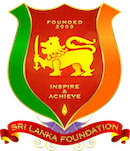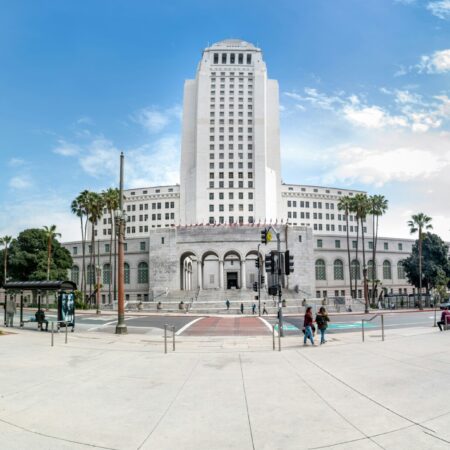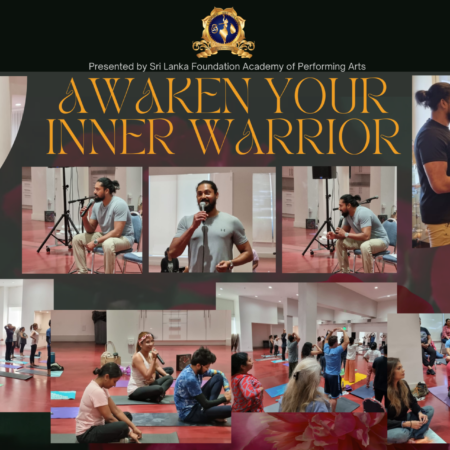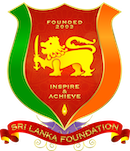My childhood is an unremarkable but memorable one. I was born and raised in Sri Lanka, mostly in Mount Lavinia, where I had a wonderful childhood. I spent most of my school years at Ananda College, where I think my personality and values were truly molded. During this time, I forged many close friendships and some of them have lasted decades later. I was also fortunate to have very supportive parents. My father, Dr. H.T. Wickramasinghe, is a well-respected Pediatrician in Colombo and has been my intellectual bedrock. Even when I was five or six years old, he really went out of his way to accommodate my crazy interests or pursuits.
After Ananda College, I took my A-Levels and was very fortunate to get 4 A’s and be selected to the Medical Faculty in Colombo. Up until that point, my life was very predictable — and I was following the career path of any typical Sri Lankan student. But my life was about to take a complete turn and I think this story is worth relating:
Around 1996, because of the admission backlog to medical college introduced by the political turmoil in the country, we were forced to wait for nearly three years before we could start our medical training in Medical School. During this time I decided to take the SAT exam. Ironically, I took the SAT because some of my father’s friends had suggested that I do it, and not because I had any desire of studying in the U.S. The real irony is that what started out as an activity to diffuse my boredom turned into a life-defining moment.
Due to not having access to a lot of SAT books, I studied at the U.S. Educational Foundation Library on Flower Road in Colombo. The librarian there was a very friendly woman and over the course of months studying there, I got to know her well. When I got my SAT scores back, I had scored so tremendously well, that she advised me that I should apply to U.S. colleges. I initially was reluctant to do so because of my parents inability to finance a foreign education, but after being told that American universities may offer scholarships, I decided to go and apply to Harvard, Stanford, Princeton, Yale and Cornell. The only places that I had heard of at the time. I then completely forgot about it for a long time.
By the Spring of 1998, I was getting ready to start medical school in Colombo since my batch was finally ready to start classes. Then on the morning of April 13, 1998( I remember because it was the Sinhalese-Tamil New Year day), I got a phone call from a Sri Lankan PhD student from Stanford University, stating that the Stanford admissions office wanted to know why I had turned down their scholarship. I was completely flabbergasted. As it turned out, there was a postal-workers strike in Sri Lanka and most of our mail was not delivered — including admission offers from Stanford, Princeton and Cornell. Fortunately for me, the Stanford offer and the Cornell offer were the only two that I managed to salvage after the deadlines had passed. Stanford’s offer, in particular, was incredibly generous offering to cover full tuition, room and board and all my personal expenses. They offered that scholarship to four international students per year back then (it has now expanded to the point that there are no limits), and I was very lucky to be one of them. They gave me exactly four days to make a decision because I had already passed the admission deadline by that time and I accepted the offer to attend the University of Stanford in California.
In a matter of four days, I made the bold decision to change the course of my life and forgo becoming a doctor in Sri Lanka and coming to the United States, where I had no family, friends, or relatives, and no chance at getting a medical education.
My wife, Dinoo, is a beautiful, kind and an amazingly understanding woman — and fortunately for my family, also a Sri Lankan-American raised in Northern Virginia. She’s supported me financially and emotionally all the way through medical school, graduate school and residency. I’m also very fortunate to have two boisterous and precocious kids. My oldest, Himali, is 5 years old and is a talkative and very sociable kindergartner. My son, Sohan, is 2 years old takes a lot after me. We currently live in Cherry Hill, New Jersey. We love it here, but I would be amiss if I didn’t confess that I would love nothing more than to return to the west coast. California always feels like home to me since I started my American life there. I hope to return to California sometime soon.
From my family history, one would predict that my father would have been my inspiration to become a doctor. This is partly true. However, the path that took me to medicine is quite convoluted. When I came to Stanford, I had disavowed any desire of becoming a doctor out of necessity. I knew that my parents could not afford to send me to medical school here, and no bank in the U.S. was willing to give me a medical school loan without a U.S. citizen co-signer. Since I was a foreign student at the time, and I didn’t know anyone who would be willing to co-sign a loan for me, I had resigned to the fact that I should just do something else.
My passion was always science, so at Stanford I naturally gravitated towards a career as a research molecular biologist. I was hooked on research and started spending a lot of my time in the research lab doing experiments — and I had a lot of fun doing it. But I really started to miss being a doctor and started to think about what my life would have been had I continued in Sri Lanka and gone through medical school.
I had just about started to think about applying to PhD programs in Molecular Biology, when my mentor at Stanford suggested to me that I look into combined MD/PhD programs. These are much harder to get into (are far more selective than traditional medical school) but come with the added bonus that they come with full funding for medical and graduate school. This sounded ideal for me. I could still be a doctor while also becoming a scientist. Unfortunately for me, funding for MD/PhD programs across the country come from the federal government so it is reserved exclusively for U.S. citizens. Another blow to my career plans, since at the time I was neither a U.S. citizen or permanent resident.
I eventually decided to just apply to MD/PhD programs anyways. I figured I had nothing to lose and the worse that could happen is that they would say no. If they turned me down, I could always enter their PhD program and become a scientist.
I was ecstatic when I got an interview offer for my dream school, the prestigious Johns Hopkins Medical School. It was too hard to believe that I got an interview offer there because I was certain that Hopkins did not accept foreign students to their MD/PhD program. I went for the interview anyways, and to my horror found out that they had made a mistake and had assumed that I was a U.S. citizen when they invited me. Nevertheless, I finished my interviews and the next day I got a call from the program director of the MD/PhD program and asked me if I would be willing to withdraw my application from other schools, if he could give me admission to Hopkins. He stated that he would have to get money from a private donor to support me since I will not be eligible for federal money. I absolutely said yes. Just two weeks later, he called me to let me know that one of the top executives at the pharmaceutical giant Merck is a Hopkins MD/PhD alum and that he was willing to grant Hopkins the money to fund my MD and PhD education. That’s how I ended up becoming a doctor.
After my MD and PhD I became intensely fascinated by cardiovascular medicine so I decided that I wanted to become a cardiologist. I stayed at Johns Hopkins and trained there for my internship and residency. From there I moved to Philadelphia to finish my cardiology fellowship at the University of Pennsylvania Hospital. I’ve now become interested in the branch of cardiology known as “Interventional Cardiology” which deals with using catheter-based strategies to treat heart disease and I will be finishing my training next year.
I think if I was asked which of these accomplishments is my greatest, I would have to say it is the accomplishment of securing a full scholarship to Stanford. That achievement single-handedly changed the course of my life. I went from being a student in a public school in Sri Lanka with no serious exposure to English to arguably one of the most selective and outstanding universities in the world. From Stanford onwards, everything else has been easier to accomplish in retrospect. I cannot imagine where I would be today had I not made the decision to come to the U.S. nearly 18 years ago. Two other very significant accomplishments that I am proud of have to do with research. At my graduation at Stanford, I was awarded the Firestone Medal which is Stanford’s gold medal for outstanding research by an undergraduate. That was a very proud moment for my parents (and one that I will not forget). The second achievement was winning the Martin and Carol Macht Research Prize at Johns Hopkins, given by Hopkins in recognition of the best PhD dissertation. I think both of those are very significant accomplishments that I am proud of. Lastly, I think my greatest accomplishment of all time, is getting my wife Dinoo to believe that I would be a great husband. I don’t think I can outdo myself again on that one nor do I intend to.
Right now, my interest is in a new branch of interventional cardiology called Structural Cardiology. This has to do with fixing heart problems with the use of catheters. I’m very excited about this and I am hoping that this will define at least part of my future career. A few years ago, patients needed to have their chest cracked open to have a valve replaced or to have their hole-in-the-heart fixed. None of that is true anymore. This is not minimally-invasive surgery, but replacing a heart valve entirely with nothing more than a needle puncture. It’s amazing to think that only a few years ago people were dying from heart valve disease when they were too old or too sick to undergo surgery. All that is changing. This new technology enables us to replace heart valves without any surgery at all. It’s called “Transcatheter Aortic Valve Replacement” (TAVR). It’s been practiced in many centers in the U.S., and we are now beginning clinical trials to extend this to nearly every other heart valve. For these reasons, I think it’s an exciting time to be a structural cardiologist. I’m also very lucky to be at one of the largest transcatheter heart valve centers in the U.S. University of Pennsylvania is the second largest program on the east coast and all that volume is going to make me technically better prepared to practice this new technology.
I did a large project a while ago during the 2005 Tsunami. Back then, I coordinated a mass relief effort when Johns Hopkins decided to donate nearly $2.5 million dollars worth of medical equipment to the Sri Lanka Ministry of Health to cover the healthcare of the tsunami affected area. I was able to do this mostly with the assistance of the Sri Lankan Embassy in Washington and the then ambassador Mr. Devinda Subasinghe.
Recently, I have adopted a new project that I am still in need of help from other Sri Lankans to get off the ground. This last January, I spent time working in the cardiac catheterization lab at the National Hospital of Sri Lanka. The doctors there was so gracious to show me around and show me how they do their procedures. You’ve got to really respect the interventional cardiologists there, and how they make use of so few resources and do amazing things with what little they have. It really broke my heart to see that because of cost restrictions they would have to sterilize and re-use catheters, guide wires and equipment that are all considered single-use in the U.S. Many patients would not get a stent after a heart-attack simply because they could not afford it.
When I came back to the U.S., I found out that at our hospital for example, a large proportion of catheter lab equipment that is marked “single-use” or “disposable” is discarded when the manufacturer’s expiration date runs out. Sometimes thousands of dollars worth of catheters, guide wires etc get tossed in the trash without ever being opened.
I’ve now started a project in Philadelphia, where I am collecting this equipment that is going to be discarded. With the help of our hospital, I’ve accumulated quite a bit of supplies that I believe patients in Sri Lanka can benefit from tremendously. I’ve already contacted the cardiologists in Sri Lanka who would love to have that equipment to be able to freely treat patients without having to reuse equipment repeatedly. What I need to find now, is a way to ship this stuff to Sri Lanka. If anyone in the Sri Lanka Foundation can help me get this to Sri Lanka, it would be an amazing help!
Yes. Anyone who is born into this country doesn’t understand how fortunate they are. If you are born in America, you have the rare opportunity to do literally whatever you want to do with your life and make your own future. Whatever it is that you find interest in, work hard and do it well. The rest will fall into place.






















